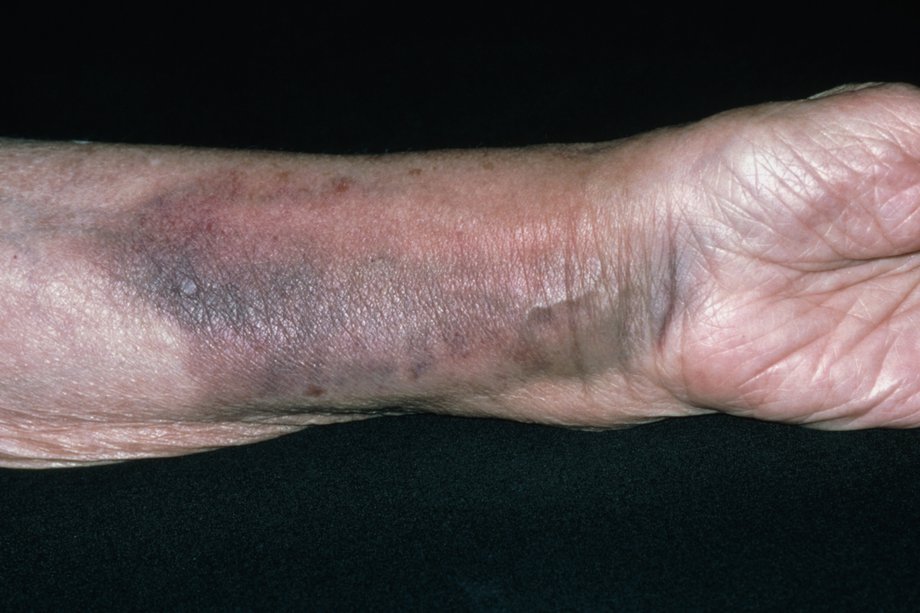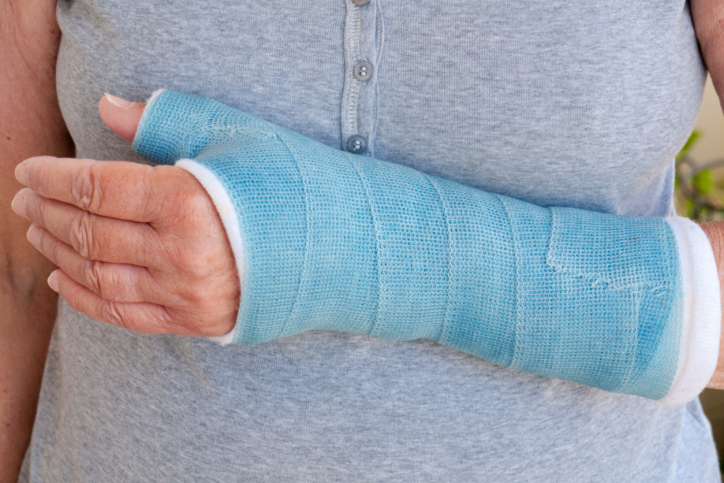There are hundreds of joints that make up the human body but none come close to the intricacy of the wrist.
Should you suspect a broken wrist, it is vitally important that you seek medical attention immediately. The scaphoid bone is the most common of the carpals to be fractured. As you would expect, a broken wrist is usually caused by breaking a fall with an outstretched hand.
This article details the correct symptoms of a broken wrist as a means of assessing your own situation. It then goes on to discuss the correct and appropriate cause of action should you wish to seek medical attention. Should you be diagnosed with a broken wrist then you will find all the relevant treatment information right here, as well as the correct recovery procedures as you look to rehabilitate your wrist back to full health.
Symptoms of a Broken Wrist
The most common symptoms for a broken wrist are:
Bruising and swelling will appear almost immediately. When a fracture of any sort occurs there will be a heavy amount of bleeding from the fracture fragments. This bleeds within the tissue and forms the immediate bruising that you notice with a broken wrist.
Pain and tenderness in the afflicted area. This pain should worsen substantially when attempting to operate the wrist joint, and worsen further still when attempting to grip or squeeze onto an object with the hand.
Tingling, numbness or both sensations may occur if the fracture has restricted bloodflow to the wrist area.
Difficulty moving the hand or arm is common and there will no doubt be a loss of motion and ability. It is uncommon that movement is lost completely, in fact, a broken wrist usually remains manoeuvrable albeit through intense acute pain.
Deformity may be apparent in the case of a more severe broken wrist. In very severe wrist fractures an end of the bone may pierce the skin, this is referred to as an open fracture.
Cracking or crunching sounds at the time of the injury are something that many people notice, and this is generally an indicator that there has been bone damage.
It can be quite tricky to accurately determine what type of injury has occurred when one falls on an outstretched hand. Is it a broken wrist, or is it a wrist sprain? These are the two most common injuries resulting from a fall, and are detailed in this article on the most common gym injuries. But how do we tell the difference? The general assumption is that the gravity of an injury directly correlates with the level of pain that the injury is causing. This is not necessarily true. In actuality, severe immediate pain is more likely to arise from a wrist sprain.
Reacting to a broken wrist
If you have strong reason to believe that you have a broken wrist, then please do see a doctor immediately. Use the symptoms above to determine this. As with any fracture, the longer you put off a diagnosis the higher the risk of a poor recovery. A delayed diagnosis can lead to insufficient healing of the fracture, loss of motion and strength, disfigurement or even disability.
If you suspect that either yourself or someone you know may have a broken wrist:
Head to your nearest A&E department (accident and emergency), or in the event of a more serious fracture, you can call 999 for the emergency services. On the other hand, minor breaks will often be treatable through a visit to minor injuries unit. Not sure where your nearest one is? Find your nearest A&E department.
Has the fractured bone pierced the skin? You will need to stop any bleeding as quickly and as cleanly as possible. Do so by applying consistent pressure to the open wound with a sterile cloth, pad or dressing.
An ice pack will most likely be an essential when treating the immediate symptoms of a broken wrist. It is recommended that each household has a cold compress in the freezer for such emergencies. If you’ve suffered the injury when out and about then don’t be embarrassed to ask for assistance.
More serious fractures may require immediate surgery upon arrival at the hospital. If you believe there to be a chance that this might happen, it is advised that you don’t eat or drink anything in anticipation of the surgery. Read other FAQs ahead of an upcoming surgery.
Try your best to rest the affected wrist as much as you possibly can. The less movement, the better. You can aid this process by making an arm sling and using it to provide supportive rest for the wrist.
I have recovered 100% with full rotation back in my wrist and I have Miss Hajipour to thank for that. I could not recommend her enough, she isn’t just a specialist in her field, she is incredibly caring for her patients’ well-being and ensures they have every option available to make their decisions, even if that means no surgery.
– Patient at BMI The Alexandra Hospital, 20th December 2017. Read more reviews.

Swelling and bruising following a broken wrist. [Img: NHS]
How to make an arm sling
Firstly, make sure the afflicted arm is getting the support it needs. Ask the injured person to provide support for the broken wrist by holding it upright with their other arm.
Next, position the triangular bandage underneath the arm with the base parallel to the body. If positioned correctly, the tip of the bandage should stick out past the elbow.
After that, slowly pull the bandage tip underneath the bad arm and around the neck, stopping at the shoulder opposite to the injured arm.
Then you can pull the other, spare bandage tip up to meet the end you have positioned at the shoulder.
Finally, tie the ends together in a knot that will be easy to undo, for example a reef knot.
Treatment for a broken wrist
Upon arrival at the hospital or A&E unit, expect to be given pain mild pain medication while you wait for an x-ray. You may also have your broken wrist fixed into a splint, and this serves the purpose of keeping your wrist in a position that doesn’t jeopardise the formation of the joint.
An x-ray will then be performed. This is standard procedure and helps us to firstly determine whether the wrist is indeed broken – if that is the case, then the images will also provide an insight into the severity and location of the fracture. From there, doctors can plan your treatment accordingly.
Treatment for minor fractures:
The most common treatment for a broken wrist will be a plaster cast or removable splint, and these are sometimes applied a few days after the break to allow for the swelling to subside. Alongside the cast or splint you may be given a sling to provide support for your arm, which will no doubt become tired with the extra weight that a cast brings. Pain medication will be prescribed to help you deal with the recovery process alongside information on how to take care of yourself while you are wearing a cast, more on that to follow. Along the way, there are going to be a couple of appointments for doctors to follow-up on the progression of your recovery.
Treatment for serious fractures:
Before any invasive surgery, a doctor may look to realign the fractured bones with their hands. Although you will not be anaesthetised for this, you will be given medicine to both numb the pain and relax you. Failing that, then surgery will be needed to realign the bones so that they can heal in their correct form – this work usually includes the use of medical framing materials such as screws and rods. As with minor broken wrists, a plaster cast will be applied to help keep the wrist in the correct position while it heals correctly. Along the way, there are going to be regular appointments for doctors to follow-up on the progression of your recovery and the condition of your cast
I was given advice on how to achieve the best outcome for my fractured wrist. There was good linked up care between consultant, physio and hand therapist. The fracture was severe, and by following Miss Hajipour’s advice the repair has been a significant success.
– Patient at Wythenshawe Hospital, 10th March 2017. Read more reviews.

A broken wrist fitted into a cast [IMG: Topsante]
Looking after your plaster cast
Plaster casts consist of a bandage wrap, covered by a hard plaster or fibreglass with the purpose of stabilising the broken wrist by encasing it. This allows the fractured bone to stay in place while it heals, and it will commonly stay in place for anywhere between 4 – 12 weeks. As you would expect, taking good care of your plaster cast is essential to making a sound recovery. Here is some additional information to help you do so.
The early stages of life with a cast need to be focused on getting the swelling down. This means keeping the arm raised, and at an angle by placing it onto a pillow or similar. It probably goes without saying, but you will be reminded that you cannot get the plaster cast wet. Doing this will only serve to weaken the cast meaning it cannot do it’s job properly. You’re probably thinking, how am I supposed to keep myself clean? Surely the cast will get wet in the shower or the bath? We recommend covering the cast in a secured plastic or rubber bag. Make sure it is watertight, but also make sure you take it off as soon as you’re done. Otherwise it will get sweaty, and this can damage the cast too.
Itchiness will no doubt be an issue, and it’s only natural that you will be tempted to have a scratch underneath your cast. We strongly advise that you don’t as it may cause further irritation. There are creams that can help with this and you buy these over the counter at a local pharmacy.
Tips to help you live with a plaster cast
Don’t fiddle with your cast. Any attempt to alter or change the position of your cast will weaken it, and it won’t be able to keep your broken wrist set in place. To help improve circulation you can exercise the elbow and finger joints, this should help with any numbness that you may be experiencing. During your time wearing a cast you are advised to refrain from doing any heavy lifting, and it is strongly advised that you do not drive.
Having trouble with your hand or wrist? You can fill out the contact form below to make an enquiry.
Error: Contact form not found.
